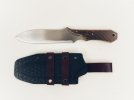First, I'm flattered that you think I use CNC! All of my blades are made with a portaband, a 1x30 belt grinder, hand sanding, and a propane forge. To me, anything that isn't stamped out by robots and produced en mass in a huge factory would fall into the "handmade" category. Using CNC and CAD is fine with me as far as handmade goes, but when you start using machines to grind bevels or shape handles for you, then I'm not so sure if you can call it handmade anymore. Some day I would love to have a CNC machine to cut impossibly intricate details into the material.
"I’m curious to know how much hand-work vs. CNC work goes into your knives, or if there’s anything else you’d like to share about how they’re made, or who exactly makes them."
I design and make everything, from the work on my website, to the finished product shipped in the box. Since I do not have the gear to heat treat my own stainless, I stick to high-carbon steel, and follow the New Jersey Steel Barron's recipes. Basically, they are soaked at austenizing temp for ~5 minutes in the forge before being quenched in Parks 50 that's been heated to about 100 degrees Fahrenheit. Then they are tempered in the oven (two cycles of two hours) at 400 degrees. I would never claim that they are a specific HRC, but using that recipe, I think its safe to assume they are coming out between 60-62 HRC. Using the Keyring Katana as an example, my process is:
- Select a steel type (now its usually 80CrV2)
- Outline the blade profile on the flat stock
- Cut/Grind out the profile
- Mark/Scribe the bevel and edge
- Pre-heat treat bevel grind
- Pre-heat treat hand sand
- Austenize and quench
- Temper Cycle 1
- Temper Cycle 2
- Soak over night in vinegar for scale removal
- Finish grind the bevel
- Finish hand sand
- Electro etch the logo
- Make the sheath
- Protect the blade with some kind of oil or wax
- Package the blade
- Ship
This can take between 3 to 5 days, depending on what comes up while its going on. I also like to update the customer with the progress and some photos to make sure everyone is happy with the final result. Its entirely a one man show with the bare minimum equipment.

